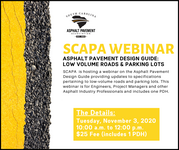The American Society of Civil Engineers (ASCE) reports that an annual investment of approximately $35 billion is needed for preserving the existing conditions of United States highways and bridges through 2040 (Economic Development Research Group, 2011). Although several factors can influence the performance of an asphalt pavement, one of the most important factors is in-place density (Asphalt Institute, 2007). A small increase in in-place density can potentially lead to a significant increase in the service life of asphalt pavements.
Date: Oct 1, 2020 03:00 PM in EDT
This webinar will focus on the best methods of addressing pavement end-of-life issues when conducting a Life Cycle Cost Analysis (LCCA), ranging from making certain that the remaining service life of a pavement is properly addressed, to understanding the importance of considering what actually happens to a pavement when it reaches its terminal serviceability, and how that needs to be included in an LCCA.
Date: October 7, 2020 3 PM EDT
Speaker: Scott Quire, Bluegrass Testing Laboratories
Asphalt mixtures containing RAP, when designed utilizing proper design principles and produced in consideration of production constraints, have demonstrated excellent performance. This part of the webinar will focus on mix designs utilizing RAP, the level of mix design analysis needed as RAP percentages increase, the production variables to consider as RAP percentages increase and performance testing of asphalt mixes containing RAP.
Date: October 28, 2020 3 PM EDT
Speakers: Dr. Randy West, Jim Musselman, Abdul Dahhan
This part of the webinar will highlight studies on field performance conducted by numerous state DOTs, the Federal Highway Administration and various pavement research organizations including the National Center for Asphalt Technology. The segment will also highlight the experiences of two pavement engineer veterans who will provide long-term perspectives of using RAP in asphalt mixtures from the Illinois DOT and the Florida DOT.












